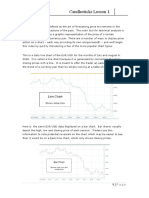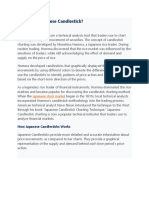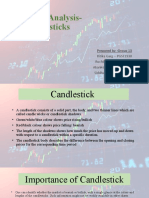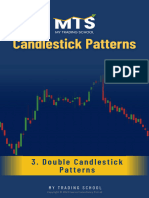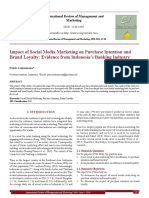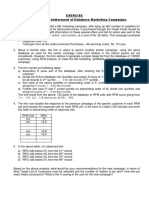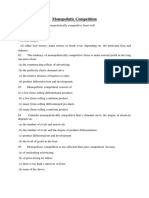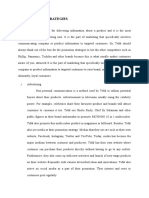Technical analysis using Japanese candlesticks
Japanese candlesticks can be used in conjunction to identify the current market conditions and the
possible future price direction. This is done by using the information they present to show the
balance between the buyers and sellers in the markets. This in turn allows you to identify the market
sentiment.
Assessing the balance between the buyers and the sellers
The longer the body of a candlestick, the more momentum there is in that direction. What this means
is:
The longer a bullish candlestick, the more buying pressure there is in comparison to
selling pressure for that period.
The longer a bearish candlestick, the more selling pressure there is in comparison to
buying pressure for that period.
Comparing candles in practice to assess the balance
The three candles to the right are all bullish candles; over the course of each of these time periods
there were more buyers than sellers (the closing price was higher than the opening price).
Candle 2 is larger than candle 1. This indicates that there was more momentum to the upside in the
second candle compared to the first. The buyers were able to push the price higher in the same
amount of time as the first candle. Comparing the candles, it can be seen that the balance is shifting
more and more in favour of the bulls.
�Candle 3 is even larger than candle 2. This indicates that not only is the balance continuing to shift in
favour of the bulls, but the momentum in buying pressure is continuing to increase as well.
Comparing bearish candlesticks in the same manner
The candles to the right are all bearish, meaning that over the course of these time periods there
were more sellers than buyers. In comparison, candle 2 is larger than candle 1, indicating that there
was more momentum to the downside in the second candle compared to the first.
The sellers were able to push the price lower in the second candle than in the first, and it can be
seen that the balance has shifted more in favour of the sellers.
Candle is much larger than candle 2, indicating that not only is the balance continually shifting in
favour of the bears, but the momentum in selling pressure is increasing too.
Observing this kind of shift in the balance between the buyers and sellers helps to determine
whether the market sentiment is likely to be bullish or bearish. If the balance is shifting towards the
bulls, then the direction of the market is likely to be to the upside; if the balance is shifting towards
the bears, then the direction in the market is likely to be to the downside.
�Interpreting the size of the candlestick wicks
The candlestick to the right is a bullish candle. It has a long wick at the bottom and almost no wick at
the top. During the time frame of this candle forming, the bears attempted to push the price down.
However, the balance shifted back towards the bulls and the buyers pushed the price back past the
opening price – the candle ended up closing as a bullish candle.
The illustration to the right shows how the candle could have looked during its formation.
The fact that the bulls managed to push the price back up from the low of the candlestick, past the
open, and up to where it closed, indicates strong momentum in buying pressure.
A long wick, such as the illustration above to the right shown as number_1, therefore indicates that
during the course of the candle, a shift in balance occurred from one side to the other– in this case
from the sellers to the buyers. This provides an insight into which direction the momentum is likely to
continue occurring.
The doji candlestick
A doji candlestick pattern is a candlestick in which the opening and the closing price are the same.
This type of candle is neither bullish nor bearish and indicates that the buying and selling pressure is
relatively equal – there is indecision in the market. A doji can sometimes indicate a reversal if found
at the end of a large price movement.
�If there is a difference of just a few pips between the open and the closing price, then it is
generally still considered to be doji.
Caution with interpreting open candlesticks
A candlestick that is still open does not provide any useful information as the dynamics of that
candle can still change. This means that you cannot analyse the very last candle on the price chart;
you can only analyse the prior candles. This is very important to know when making decisions about
trading.
The illustration above and to the left shows a 4 hour chart. The last candle shown is still open and
has not finished forming. The price is moving to the upside indicating a strong bullish tendency. At
this point, the buyers are in control and it appears that this will form as a bullish candle.
However, the chart to the right shows that within the time period of the four hours, the candle
changed completely. The balance has shifted towards the bears. It now appears that the candle will
form as a bearish candle.
Until the candle closes, there is no way to tell how the candle will eventually form. You should not
make assumptions, carry out analysis or enter trades based on an open candle.
�Gaps between open and close of the candlesticks
You may notice that in the illustration examples provided, each candlestick opens where the
previous candlestick closes. Although this is logical, it is not always the case. As the illustration to
the right demonstrates, occasionally a gap 1 is created between the close and the open of two
candlesticks.
There are multiple reasons for gaps, the main one being that the price shifted while the normal
markets were closed. Therefore, the opening price will be different to the closing price when the
markets open again.
Summary
So far, you have learned that:
the longer the body of a candlestick the further the price moved in that time period and so
the more momentum there is pushing the price in that particular direction.
an increase in market sentiment can be identified by comparing the candlesticks against one
another.
a bearish body means that sellers are currently in control and a bullish body means that the
buyers are currently in control over the course of that period.
long wicks indicate that there has been a shift in balance between the buyers and sellers –
from one side to the other – within that period.
a doji candlestick represents market indecision where neither the buyers nor the sellers were
in control.
only a closed candlestick should be taken into account because the sentiment can change
within the time of that candle.
